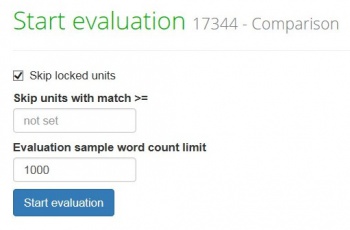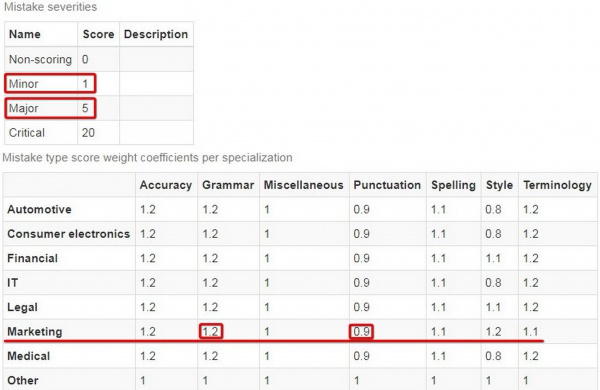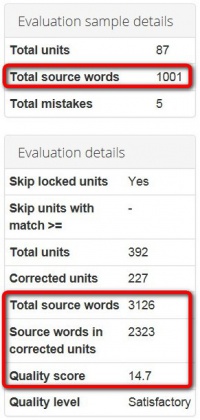Difference between revisions of "Quality score formula"
(→How Quality Score is calculated for several projects?) |
(→How Quality Score is calculated for several projects?) |
||
| Line 61: | Line 61: | ||
In evaluating the quality score of several projects, the formula indicators are summarized for all projects. | In evaluating the quality score of several projects, the formula indicators are summarized for all projects. | ||
| − | To put it simply, | + | In evaluating the quality score of several projects, the corresponding projects indicators are summarized and calculated according to the formula given above. |
| + | |||
| + | To put it simply, let's culculate quality score | ||
Revision as of 12:31, 13 February 2019
Contents
How Quality Score is calculated?
Quality score reflects the number of mistakes made per 1000 words of translated text.
The formula is:
Quality score = Σ(mistake_severity.score * mistake_type_spec.weight) * project.evaluation_corrected_word_count / project.evaluation_sample_word_count / project.evaluation_total_word_count * 1000, where:
- Quality score - the number of "base" mistakes per 1000 words ("base" mistake - the mistake that has the severity score of 1 and the weight coefficient of 1).
- Σ - the sum of products of the mistake severity score and the weight coefficient of the mistake type per specialization.
- mistake_severity.score - the mistake severity score.
- mistake_type_spec.weight - the weight coefficient of the mistake type per project specialization.
- project.evaluation_corrected_word_count - source words in corrected units in the evaluation sample.
- project.evaluation_sample_word_count - total source words in the evaluation sample.
- project.evaluation_total_word_count - total source words after evaluation start filter is applied.
How the number of translated words is selected?
To make it simpler, let’s make an example:
Before starting the evaluation, the reviewer selects the number of words to evaluate:
Now imagine that the whole translated text (marketing specialization) contains 3126 words, and the editor corrects the segments containing 2323 source words.
You select 1000 words sample which is randomly taken by the system out of 2323 source words in corrected units and add 5 mistakes of different types and severities. Two of them are minor punctuation mistakes
(the severity score of 1 and the weight coefficient of 0.9 for every mistake), and three of them are major grammar mistakes (the severity score of 5 and the weight coefficient of 1.2 for every mistake):
Note: By default, the system has pre-defined quality standards, but you can define your own corporate quality standards.
As a result, we get:
Quality score = Σ(1*0.9+1*0.9+5*1,2+5*1,2+5*1,2)*2323/3126/1001*1000=14,699
You’ll be able to see these numbers on the evaluation page:
Where:
- Quality score = 14,7.
- project.evaluation_corrected_word_count = 2323.
- project.evaluation_sample_word_count = 3126.
- project.evaluation_total_word_count = 1001.
Why is it made that way?
We came to this through several stages of evolution.
First, the system was selecting just the beginning of the text, and we found out that the translators started to translate first 1000 words better than the rest of the text. So we decided to select the random part of the text. But then the system sometimes selected the pieces containing no corrections while skipping heavily corrected parts. So we changed the logic, and now the system returns the required number of corrections to the evaluator, but remembers how much text it took to find these corrections.
How Quality Score is calculated for several projects?
In evaluating the quality score of several projects, the formula indicators are summarized for all projects.
In evaluating the quality score of several projects, the corresponding projects indicators are summarized and calculated according to the formula given above.
To put it simply, let's culculate quality score


